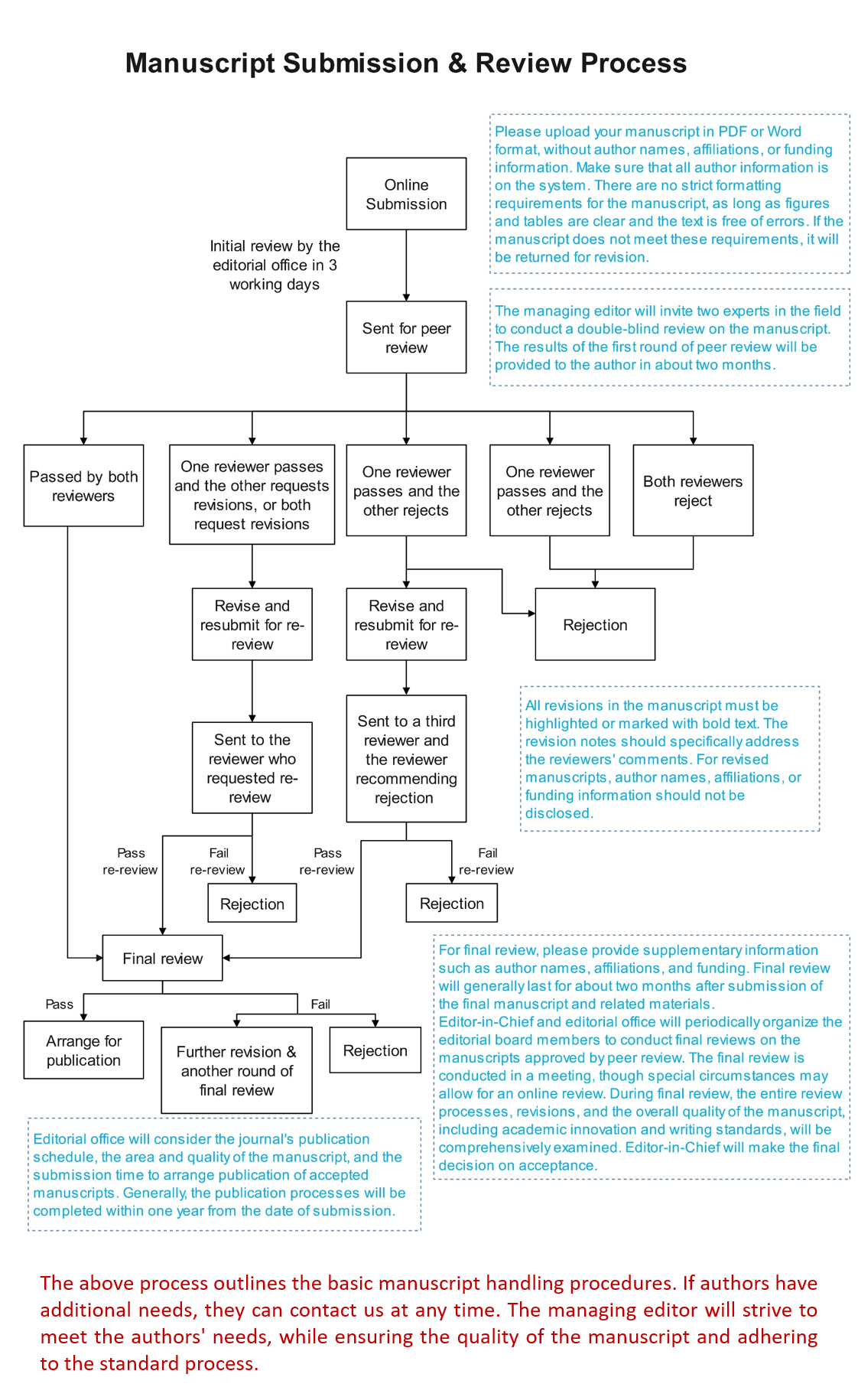1. Review Process
TNUAA employs a "three-tier review system" for manuscript evaluation, consisting of an initial review by the editorial office, a double-blind peer review by experts, and a final review by the editorial board. All submissions are first subjected to an initial review by the editors to determine their suitability for the journal. Manuscripts deemed appropriate are then sent to at least two independent experts to assess their academic quality. For manuscripts passing peer review, the Editor-in-Chief and the editorial office periodically organize the editorial board members to conduct a final review, with the Editor-in-Chief making the final acceptance decision. The detailed process and related explanations are illustrated in the following diagram:

Additional Review Notes:
(1) The above review process applies to all submissions to TNUAA, including those submitted to supplementary and special issues. The Editor-in-Chief is responsible for all content of the journal (including supplementary and special issues).
(2) For some special issues, the journal may invite experts in relevant fields to serve as guest editors to improve the academic quality and impact of the special issue. The activities of guest editors are supervised by the Editor-in-Chief and the editorial office to ensure the fairness of the review process.
(3) Submissions by the journal's editorial board members, reviewers, and guest editors also adhere to all the journal's review procedures. The reviews are conducted independently of the involved editorial board members/reviewers/guest editors and their research groups. Furthermore, these individuals are not allowed to participate in the review process of articles written by themselves, their family members, colleagues, or others with whom they have a conflict of interest.
2. Detection & Handling of Academic Misconduct
TNUAA uses the CNKI Academic Misconduct Literature Check System (AMLC) to screen all submissions for potential academic misconduct, including plagiarism, duplicate submissions, and other issues.
Academic misconduct defined by the journal mainly includes:
(1) Plagiarism, theft, usurpation, or falsification of another's academic work.
(2) Intentionally making false statements, fabricating data or results, or compromising the integrity of original data; forging, fabricating, or altering research data, conclusions, annotations, or references.
(3) Submitting the same manuscript to multiple publications.
(4) Improper or excessive attribution.
(5) Participation in another's academic misconduct.
For articles involving academic misconduct, the journal rejects the submission and, depending on the severity, may take further actions. These include publicly criticizing the related articles and authors within the academic and sibling journal community, and notifying relevant institutions to administer serious administrative penalties to the principal authors.
3. Author Appeals
Authors who disagree with the review results or plagiarism check results of their manuscripts may submit a written appeal to the editorial office. Authors are required to provide a detailed explanation of their concerns and send the appeal document to the email of the editor. Upon receiving the appeal, the editor will review it promptly and communicate the decision back to the author. Please note that typically only one appeal is allowed per manuscript.
4. Corrections & Retractions
For formally published articles, the journal generally does not accept requests from authors to correct or retract the article. However, under necessary circumstances, corrections or retractions will be processed as follows:
(1) Corrections: If a published article is found to contain unintentional scientific errors that do not significantly affect the results and conclusions, the editorial office will promptly publish a correction notice in the journal. This notice will detail the changes made to the original article, and a revised version of the article will be issued with a comprehensive description of the modifications and the date of the update. When citing, the most recent version of the article should be used.
(2) Retractions: The journal will retract a published article under the following circumstances: ① if severe scientific errors are discovered that render the results and conclusions unreliable; ② if the article is suspected of academic misconduct, the editorial office will initiate an investigation and publish a statement to inform readers of the potential risks associated with the article. Upon conclusion of the investigation, the results will be made public. If academic misconduct is confirmed, the editorial office will retract the article and issue a retraction statement.
Articles

Mobile website

